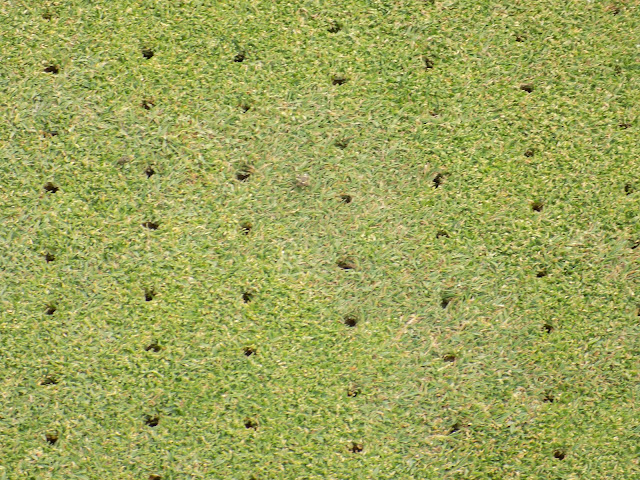We are planning on core spiking our new greens on Monday 7/25/22 to allow some important air exchange in the rootzone as well as remove some developing thatch. Our aeration plan for these new putting surfaces is to do frequent, non invasive aeration events at the proper time of the year to avoid the larger, more invasive events in the future. We have already core spiked these new greens once, and afterwards they were a little sandier then normal, hardly any noticeable holes, very puttable and were completely healed in a couple of days.
 |
Same hole pattern and size of hole we will be ding on Monday. |
 |
Light topdressing afterwards |
 |
Brushing in the sand after light topdressing. We irrigate afterwards to further wash the sand off of the surface. |
Poa Prevention
A strategy that is related to aerification events is poa annua encroachment. Poa seed likes to get started in aeration holes and poa annua infestation will be a battle with these new greens despite the availability better tools to combat it's encroachment. One strategy that we plan to employ is to not aerate, or open up the greens, when poa is actively germinating and producing seed. In our area, poa starts to germinate as early as late August early September and continues through the spring of the following year. Therefore our best line of defense against poa getting started in our greens is to have a dense stand of bentgrass prior to it's germination period. That means most of our cultural practices on the greens need to happen in late May through mid August.
The danger of aerating in the summer is the high temperatures associated with this time of the year. Aerification practices of any type, although necessary, are inherently stressful to the plants. When you add high temperatures to the mix it can be risky. Good news is we are planning on small frequent aeration events which by scale are less risky and at the same time substantially less impactful to putting quality. Additionally, with fewer Monday events we have more flexibility with scheduling around extreme weather forecasts.
Tuesday the greens will be a little sandier then normal but will putt just fine. By Thursday we should be pretty close to normal.
Aeration and cultural practices on putting surfaces are just something we have to do and these practices are likened to Benjamin Franklin's famous exhortation, "An ounce of prevention is worth a pound of cure". I'll update with fresh pictures next week.
Thanks for your support. The Best Is Yet To Come!



No comments:
Post a Comment